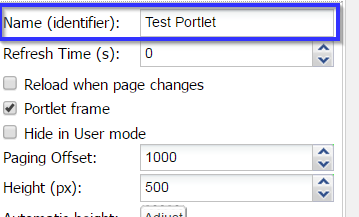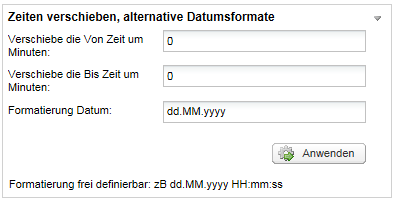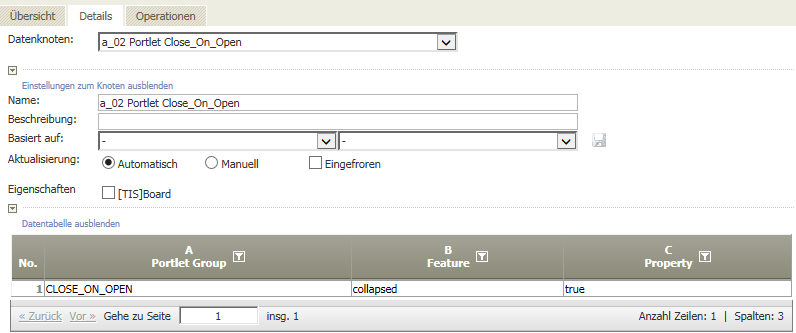TIS Board - Adjust Portlet
Summary
This operator modifies the properties of different portlets upon recalculation of the operator. The properties that can be modified by this operator are can be found in the List of Portlet Properties
It must be based on a table with three text columns containing
- the identifier of the portlet to be modified, which is the "Name (identifier)" property of the portlet, a general portlet property (see List of Portlet Properties),
- the internal name of the property (see column "Internal name" in List of Portlet Properties), and
- the value to be assigned to the property (see columns "Type" and "Description" in List of Portlet Properties).
Each row of the table hence defines a property value for some portlet. Upon recalculation of the operator all portlets' properties in the table are adjusted.
The recalculation can be triggered manually in the Data Node in TIS Editor or by a portlet event (see Event Handling with Portlets).
Example
Enter an identifier as "Name" property in the portlet you want to adjust.
This identifier has to be unique for the TIS Project from which the portlet should be adjusted. | |
In TIS Editor | Create a Data Node with a table (e.g., the Create Table operator) containing the three text columns described above and enter values in the table.
|
In TIS Editor | Add the operator TIS Board - Adjust Portlet and select columns accordingly |
Optional: Bind it to an event | You can bind the recalculation of the operation, i.e., the adjustment of the portlet, to an event, see Event Handling with Portlets. For example, this way the portlet can be adjusted on logon. |
Example: Collapse specific Portlets when User logs on
Situation | To make screens nicer, it canbe helpful to collapse some portlets at log on. |
|---|---|
Settings | This Portlet should be collapsed when open. Give it an ID in the Portlet Designer  Define a data node in the Project with the table and the Change Portlet Operator And at any portlet we specify an action for the logon (=Anmelden) Event refering to this node. |
Result | The portlet is collapsed after logon |
Project-File | Analyzer V06.01 A Auswertung |
Want to learn more?
Settings
Modify properties of one or multiple dashboard portlets.
Columns of input table
Parameter
Examples
Example 1: ...
...
Calculation method | Settings | Result |
|---|---|---|
... |
Troubleshooting
Problem | Frequent Cause | Solutions |
|---|---|---|
... | ... |
Related topics
- Event Handling with Portlets
- Portlet Property
- "Reload page layout" property of Controller (Portlet)





